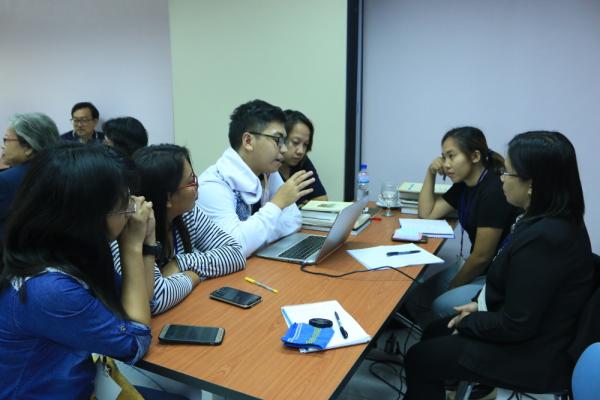Coastal risk and vulnerability: 3 non-specialist tools to assess integrity, fisheries, and climate change
Thursday, 7 March 2019

PEMSEA hosted a Regional Training Workshop on Risk and Vulnerability Assessment from 4-5 March. Participants from PEMSEA Network of Learning Center members from Indonesia, Thailand, and Timor-Leste joined local government officers from five Philippine provinces to learn how to use and understand three non-specialist tools developed to help assess the vulnerability and resilience of coastal areas and communities.
Teaching and instruction was provided by Dr. Samuel Mamauag, Ms. Yvainne Sta. Maria, and Mr. Renmar Martinez of the Marine Science Institute, an academic institute of the University of the Philippines. A combination of presentation, discussion, and working through existing case studies from areas of the Philippines allowed participants to fully engage with the tools provided, and bring up questions and thoughts as the process went on.
The three tools discussed focus on different aspects of coastal management, and can be used individually on in conjunction with each other. They are useful for assessing current and future threats, as well as providing insights into potential implications of human activities.
Coastal Integrity Vulnerability Assessment Tool
The Coastal Integrity Vulnerability Assessment Tool (CIVAT) provides a framework to assess the vulnerability of the coastal zone to physical processes such as erosion and flooding. The potential impact of these processes is a combination of its exposure to coastal dynamics, such as wave action, and its biophysical sensitivity, such as predisposition to erosion. The ability to resist and recover from such events, a property called adaptive capacity, provides the other component of assessing vulnerability. Analyzing adaptive capacity involves looking at factors such as sediment supply that will counteract potential damages from possible impacts.
CIVAT not only assesses threats to a coastal area, but also provides rough indication on how human activities and development may affect the area’s vulnerability. Its results provide useful information about the potential effects of climate change to the vulnerability of a coastal area, with sea level rise and other impacts likely to create significant shifts.
Tool for Understanding the Resilience of Fisheries
Climate change brings a range of new threats to fish populations, such as changes in ocean temperature and shifts in ocean currents. Fish populations are a complex and can be disturbed in multiple ways. Within the Philippines alone, over half of all small-scale fisheries are already considered unsustainable.
How can they be managed more effectively, and what are the risks facing local fishing communities? The Tool for Understanding the Resilience of Fisheries (TURF) looks through both the socioeconomic and ecosystem components of a fisheries, to assist decision-making at a local level. TURF examines the relationship between fish catch composition, habitat condition, species composition of the area, and the socioeconomic situation to determine the overall vulnerability.
Integrated Coastal, Sensitivity, Exposure, Adaptive capacity for Climate Change tool
The enormous biodiversity in coastal habitats are highly important for nearby communities, providing nutrition as well as a diverse range of ecosystem services. However, coral reefs, seagrass beds, and mangroves are sensitive ecosystems. The impacts of climate change, including rising temperatures and sea levels, will put huge pressure on them and on the services they provide. The Integrated Coastal, Sensitivity, Exposure, Adaptive capacity for Climate Change tool (ICSEACC) uses a framework combining exposure, sensitivity, and adaptive capacity to determine vulnerability.
Threats posed by climate change can be detected by looking at changes in the extent of coastal habitats, the type of and the dependence on fisheries, and the integrity of the local coastline. These three components vary in their sensitivity, exposure, and adaptive capacity, and so threats to each need to be considered in turn to obtain an overall picture of vulnerability. Assessing different areas of a coastline provides a clear indication of which sections are at most risk from climate change, and can help identify components that may aggravate these risks.
Potential of tool usage
Climate change adaptation should be integrated into planning processes, and mainstreamed into coastal development practices. Each development tool has its own focus, but there are areas of overlap due to the inter-relatedness of the different aspects of coastal management. Using all three provides a holistic overview of the vulnerability of an area, especially useful in the context of integrated coastal management (ICM).
Their focus on ease of use and simplicity means they can be used by anyone involved in ICM, even non-specialists, expanding the potential capacity of local governments and other stakeholders. Dr. Ario Damar, Director of Centre of Coastal and Marine Resources Studies of Bogor Agricultural University and participant in the workshop, highlighted this benefit, and was optimistic that trainees in his local area could make use of these tools.
All three tools were developed to be general, but were refined and tested in a Philippine context. Dr. Praparsiri Barnette, Head of the Department of Aquatic Sciences in Burapha University, noted that “modifications will need guidance” and that the workshop was helpful in allowing discussion among participants who are each familiar with their own coastal area.
While these tools were useful in assessing the status of an area, Mr. Leonito Amaral Aleixo, Dean of the Agricultural University within the National University of Timor-Leste, recognizes the need to translate and incorporate the assessment results into immediate action. He noted, “Wherever you go climate change is climate change… How does the result [then] become implementation?
Through using these tools, local governments will be able to engage in this essential process of turning results into implementation. As the tools become tested in more local areas and thus engage in a wider range of environments, ecosystems, and communities, they will become further refined and increasingly robust. Local knowledge will unlock local solutions, and these tools bring potential local knowledge within easy reach of local governments.
A full report on this training workshop can be found here.



